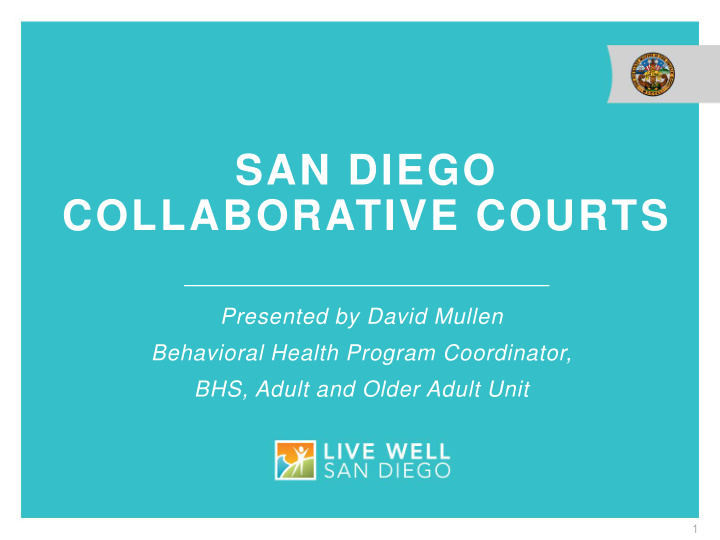



SAN DIEGO COLLABORATIVE COURTS Presented by David Mullen Behavioral Health Program Coordinator, BHS, Adult and Older Adult Unit 1
DEFINING COLLABORATIVE COURTS Also referred to as “Diversion Courts” Team Approach: • Judges • District Attorney • Public Defender • City Attorney • Sheriff and Law Enforcement (Police Dept.) • Probation • Treatment provider Utilizes both support and law enforcement leverage to encourage recovery and reduce recidivism. Approximately 18 months in duration. Phased system of treatment. Sanctions and rewards are utilized. Generally includes lower-risk, non-violent participants. 2
PURPOSE OF DIVERSION COURTS To improve lives impacted by substance abuse and/or mental illness and to increase public-safety by reducing the crime associated with these challenges. Reduce high incidence of recidivism (re-incarceration). Link justice-involved people with the treatment, resources and support they need. 3
PROGRAM ELEMENTS “Phased” Treatment Utilizes rewards and sanctions Regular contact with Judge and Team Group/Individual Counseling, Case Management and Drug Testing Education, Job and Health referrals 4
VARIETIES OF DIVERSION COURTS IN SAN DIEGO COUNTY Drug Courts Re-Entry Court Behavioral Health Court Mandatory Supervision Court Veterans Treatment Court Homeless Court 5
ARE DIVERSION COURTS EFFECTIVE? FY 16-17 Drug Court Outcomes: 98% of clients that have completed treatment are employed or initiated employment preparation All babies born to program clients were drug-free 100% of clients that have completed treatment have no new criminal activity resulting in a conviction 6
OTHER DIVERSION PROGRAMS Community Justice Initiative San Diego Misdemeanants At Risk (SMART) PC 1000 7
QUESTIONS THANK YOU • 8
Recommend
More recommend